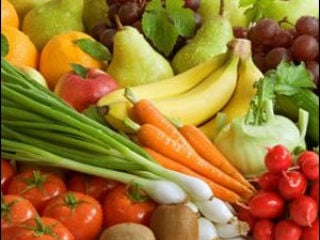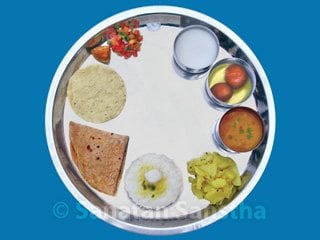This article answers few frequently asked questions on basic conducts associated with meals.
1. Why is serving of food by
women more appropriate than self-service ?
The consciousness of an individual about the self is more while eating. Therefore, the personality defects in its Manodeha (Mental body) erupt and its sattvikta (Purity) reduces. For the progress of an individual from ‘swechha (One’s own wish) to parechha (Other’s wish)’, and later for it to carry on worldly activities as ‘Ishwarechha (God’s wish)’, Hindu Dharma has implemented a process where a woman serves food taking an individual from ‘swechha to parechha’
A woman is Shakti (Divine Energy)-form and hence, she is able to harmonize with the environment. As a result, her ability to supply manifest energy to a greater extent is enhanced. Hence, Hindu Dharma advises that the tasks associated with manifest energy source be mainly performed by women. Eating is a medium of obtaining energy, and since a woman is more sensitive in awakening the source of Shakti in the environment according to the requirement of the task, Hindu Dharma advises that food be served by women.
2. What precautions should
be taken while serving food?
In today’s times, the extent of oily and spicy items is more in meals, and such items are Raja-Tama-predominant. Similarly, an ordinary individual too is Raja-Tama-predominant and hence, the spoon in its hand also gets charged with Raja-Tama waves. If such a spoon touches the plate or the item in it, the flowing waves in the spoon will activate the Raja-Tama-predominant energy in the item and a mandal of these waves will be created around the plate. Likewise, due to any activity that creates distressing sound, the distressing vibrations from Patal (Hell region) and the premises get activated, and after some time these waves are emitted into the environment. Consequently, the movement of negative energies in the premises also increases. Therefore, try to avoid touching the plate or the food in it while serving food.
3. Why should the utensils containing food
not be placed behind the people who are eating?
Food is considered ‘Purnabrahman’. Placing the utensils containing food behind the people who are eating is akin to insulting the Shakti Principle of Shri Annapurnadevi in the food, which has been awakened by invoking Her. If the individual has a bhav (Spiritual emotion) that it is eating food as Prasad (Holy sacrament) of Shri Annapurnadevi Principle in the food and with full respect towards Her, the food becomes ‘Purnabrahman’ from the individual’s perspective.
4. How many hours should elapse
after a meal before we eat something more?
If the afternoon meal is heavy, do not eat at night. Generally, adults should not eat for three hours after a meal, while those performing hard manual work should not remain without food for more than 6 hours.
5. Why should we offer food as
Naivedya to the Deity before consuming it?
When food is offered to the Deity as Naivedya and then partaken as Prasad, we benefit from the Deity Principle and Chaitanya (Divine consciousness).
6. Why should we face the east while eating?
According to the conducts mentioned by Dharma, when any activity is performed in an appropriate environment, it maintains an appropriate equilibrium in the respective energy waves that are in motion in the universe and thus, it does not disturb the equilibrium of the environment. The direction east is complimentary to Tej (Absolute Fire Principle). Eating is very much a Yadnyakarma. When this Yadnyakarma is spread into the body with the help of the energy of Tej in the direction east, it helps speed up the process in an appropriate manner. Acts performed through the contact of respective waves while facing the appropriate directions helps in destroying the demerits & obtaining merits.
7. Why should food not be eaten
while dressed in a single garment?
When an uparne is worn on the shoulder, the sattvik waves emitted by the body are effectively emitted into the environment. Thus, upavastra purifies the environment around the individual and wards off the obstacles of negative energies in the process of eating; while the tightly worn cloth around the waist helps the body get the benefit of sattvikta at the individual level. Therefore, instead of eating while dressed in a single garment, it is more beneficial to take the help of the upavastra that represents Shakti.
8. Why should we wash face,
hands and feet before eating?
Washing the face, hands and feet before eating food helps in removing the particles of dust on them. When food is eaten with the hand that has dust particles on it, the Raja-Tama-predominant waves emitting from Patal and from the environment get attracted to the fingers and spread into the food. Having such food is likely to cause distress due to negative energies. On washing the feet, due to the presence of the Apatattva (Absolute Water Principle)-predominant waves in water, the pranamaya-kosha (Vital energy sheath) gets activated. Consequently, the ability of the body to receive sattvik waves from the universe while eating is enhanced. Subsequently, with the help of the Apatattva, these sattvik waves are made to flow and thereby made to penetrate each cell of the body and spread into the manomaya-kosha (Mental sheath). This reduces the number of useless and Raja-Tama-predominant thoughts, and as a result of the sattvikta obtained, the digestion of food is better and leads to good health.
9. Why is serving food on banana leaf preferred?
Eating food served on a banana leaf while sitting on a wooden seat bestows health. Banana leaf is Holy, contains Chaitanya and is Divine. Regularly eating food from a banana leaf creates an invincible protective sheath around the individual. The individual who eats from a banana leaf experiences the sagun (Materialized) Chaitanya in the banana leaf in the form of ‘feeling good’. A ring of sagun Chaitanya (1%) is created around the Anahat-chakra of the individual eating. Therefore, he does not suffer from abdominal disorders. A ring of Chaitanya is also created at the Adnya-chakra of the individual eating at a slow pace. It purifies the mind of the individual and makes it calm.
10. What is the importance of
drawing rangoli around the leaf or plate?
Rangoli symbolizes auspiciousness. Auspicious components such as turmeric and kumkum used for colouring rangoli attract bhumi-lahari (Earth waves) and Shakti-lahari (Waves of Shakti) from the environment and gather in the shape of the rangoli. These waves protect the food plate as per the requirement from the attacks of negative energies in the environment. Since a covering of bhumi-lahari waves and Shakti-lahari also forms beneath the plate, the food items in the plate get charged with the respective waves. Since these waves enter and spread into the body through the medium of the food, the process of digestion speeds up, and these waves congregate in the body. Drawing rangoli around the plate leads to emission of sattvik waves from the rangoli and helps in creating a circular and moving protective sheath around it. Sattvik waves emitted by the rangoli help to some extent to eliminate the negative energy covering of Raja-Tama-predominant waves around the food.
10. Why is a sattvik
incense-stick lit near the plate?
Due to the effect of the fragrance of sattvik and fragrant incense-stick, Principles of Deities from the universe get attracted to the respective area. This brings about purification of the air and the area of activity. While enjoying food in such a Chaitanya-enriched environment, due to the spread of sattvikta into the body, the mind becomes cheerful. A cheerful mind is conducive to sattvik thoughts. It is on the strength of sattvik thoughts that an individual progresses spiritually.
11. Why should one chant
God’s Name while eating the food?
Chanting the Name of God while eating makes the process of digestion easier. Food is Purnabrahman and is one that gives life. Eating food is not just filling the stomach but is a type of Yadnyakarma. Food that imparts life to us is Purnabrahman. Do not eat it merely for filling the stomach; offer it as oblation in the Yadnya of life, so that the energy obtained from that food will encourage you to perform good deeds and help others. Expect no fruit from this meritorious karma and offer it (the karma) to Shrihari so that your objective of eating food is fulfilled.

 For healthy living avoid food that can cause antagonism due to contra-indications
For healthy living avoid food that can cause antagonism due to contra-indications Ill effects of artificial cold drinks
Ill effects of artificial cold drinks The connection between food and disease, important analysis on digestion
The connection between food and disease, important analysis on digestion The method of preparing rice is important !
The method of preparing rice is important ! Give up junk food and embrace Ayurveda
Give up junk food and embrace Ayurveda Should sweets be eaten at the beginning or end of a meal ?
Should sweets be eaten at the beginning or end of a meal ?